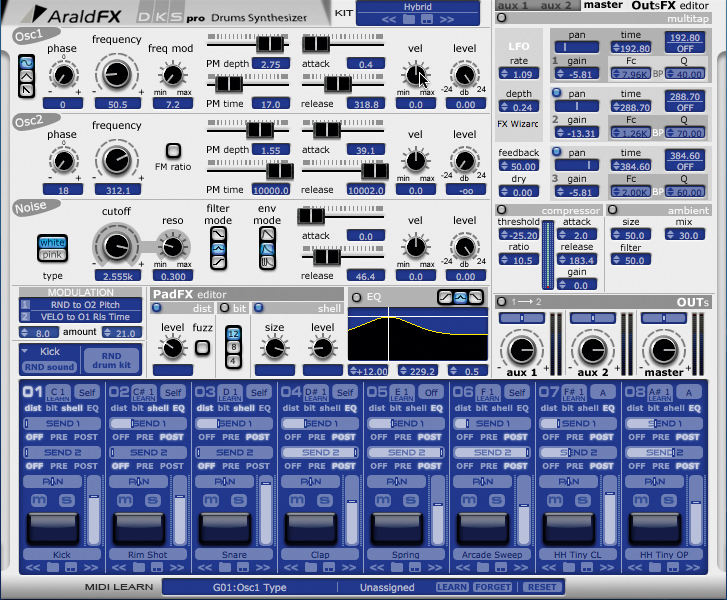MusicRadar Verdict
It won't replace your drum sampler, but DKS Pro is worth considering if you want another rhythmic tool. Let's hope this is just the beginning.
Pros
- +
Multiple synthesis methods. Randomisation makes our pulses pound. Good selection of effects. Lots of useable presets . Easy to use.
Cons
- -
More modelling, please. Audio glitches that sometimes overload the outputs.
MusicRadar's got your back
It's been said that old is the new new. This is especially true in the music industry, where instrument manufacturers indulge their nostalgic instincts with a steady stream of retro-inspired gear.
While much of the emulative attention has been focused on old analogue synths and tube-laden outboard processors, there's been no small demand for vintage drum machines.
Indeed, the trusty Roland TR-808 may well have been the first 'chic antique' on the second-hand music tech market, while its successor, the TR-909, is equally desired, particularly by dance producers.
Unfortunately, vintage instruments command lofty prices and an endless supply of patience. This being the case, drum synths (both hard and soft) have undergone a sort of resurrection in recent years.
Sampling techniques
Most modern drum machines take one of two forms. The majority are sample-based, but the problem with samples is that they're inherently 'static'.
The other type of drum machine, in which sounds are derived from analogue synthesis, is compromised by what is a relatively simplistic tone generation method.
In order to cover more ground, some instruments use both sampling and synthesis to generate their sounds. Look a little more closely, though, and you'll find that it's not just analogue synthesis that's useful for creating percussion sounds.
Want all the hottest music and gear news, reviews, deals, features and more, direct to your inbox? Sign up here.
Physical modelling, for instance, formed the basis of Korg's Wavedrum (one of the first modelled instruments ever to be released) and FM synthesis can also be called upon to create interesting drum sounds.
AraldFX are well aware of the power of all of these techniques and have combined them into a single instrument: DKS Pro. The developers carefully studied many much-loved vintage drum machines, and their new plug-in is a hybrid beast, featuring the best of what each synthesis technique has to offer.
"The developers carefully studied many vintage drum machines, and their new plug-in is a hybrid beast, featuring the best of what each has to offer."
Hands on
DKS Pro's layout is familiar: eight pads are splayed across the bottom of the GUI, while a voice editor above displays the parameter settings for the currently selected pad.
Each pad has an identical architecture: a pair of analogue-style oscillators with selectable waveforms, a noise generator and a filter.
Oscillator 1 gives you a choice of three different waveforms, while Oscillator 2 can modulate Oscillator 1 for FM effects.
The FM facilities go far beyond the usual analogue-style FM, though - you're given control over the frequency, ratio and phase. Both oscillators have two-stage envelope controls and velocity modulation is independently addressable for each.
DKS Pro's filter is of the multimode variety and has a two-stage envelope built in. In addition, you can select the type of envelope you want to use (there's even one specifically for claps, cracks and the like).
No modern drum machine would be worth its salt without built-in bit-reduction effects, and they're present and correct in DKS Pro. You can select 12-, 8- or 4-bit playback and add some tasty fuzz to the lot with the dedicated distortion effect.
Destructive effects aren't the only ones on offer. You'll also find compression and ambience and - unusually for a drum machine - a multi-tap delay. This features a LFO for bizarre modulations.
Now, we did say that DKS Pro offered physical modelling, did we not? Don't get too excited, though, as this is limited to a modelled drum 'shell': you can choose the size of the shell and the level, but that's all.
We were hoping to find a full-on acoustically modelled oscillator built entirely on exciters and resonators, but sadly, there's nothing of the sort.
However, resonators are represented by the shell model, and depending on the sound being pumped through it, it can add a lot of life to the tone.
The shell functions are most obvious when applied to snares, percussion and other frequency-rich timbres.
In use
There are a lot of drum machines on the market, but few feature as many sound generation techniques as DKS Pro.
What's more, the included modelling features have whetted our appetites for more - we would love to see an acoustically modelled oscillator. That said, there's plenty going on here already, and the interface is certainly easy to navigate.
We did suffer from a few audio 'blow ups' when we were scrolling through the included drum presets on our Intel iMac, but AraldFX are aware of this issue and say that a fix is in the works.
On the whole, the sounds range from good to excellent. DKS Pro is not meant to replace your drum sampler, but if you have a taste for electronic percussion, it's well worth a look.
The unusual parameters ensure that you'll be able to carve out your own sonic identity and there's definitely scope for DKS Pro to be developed further.
Computer Music magazine is the world’s best selling publication dedicated solely to making great music with your Mac or PC computer. Each issue it brings its lucky readers the best in cutting-edge tutorials, need-to-know, expert software reviews and even all the tools you actually need to make great music today, courtesy of our legendary CM Plugin Suite.

